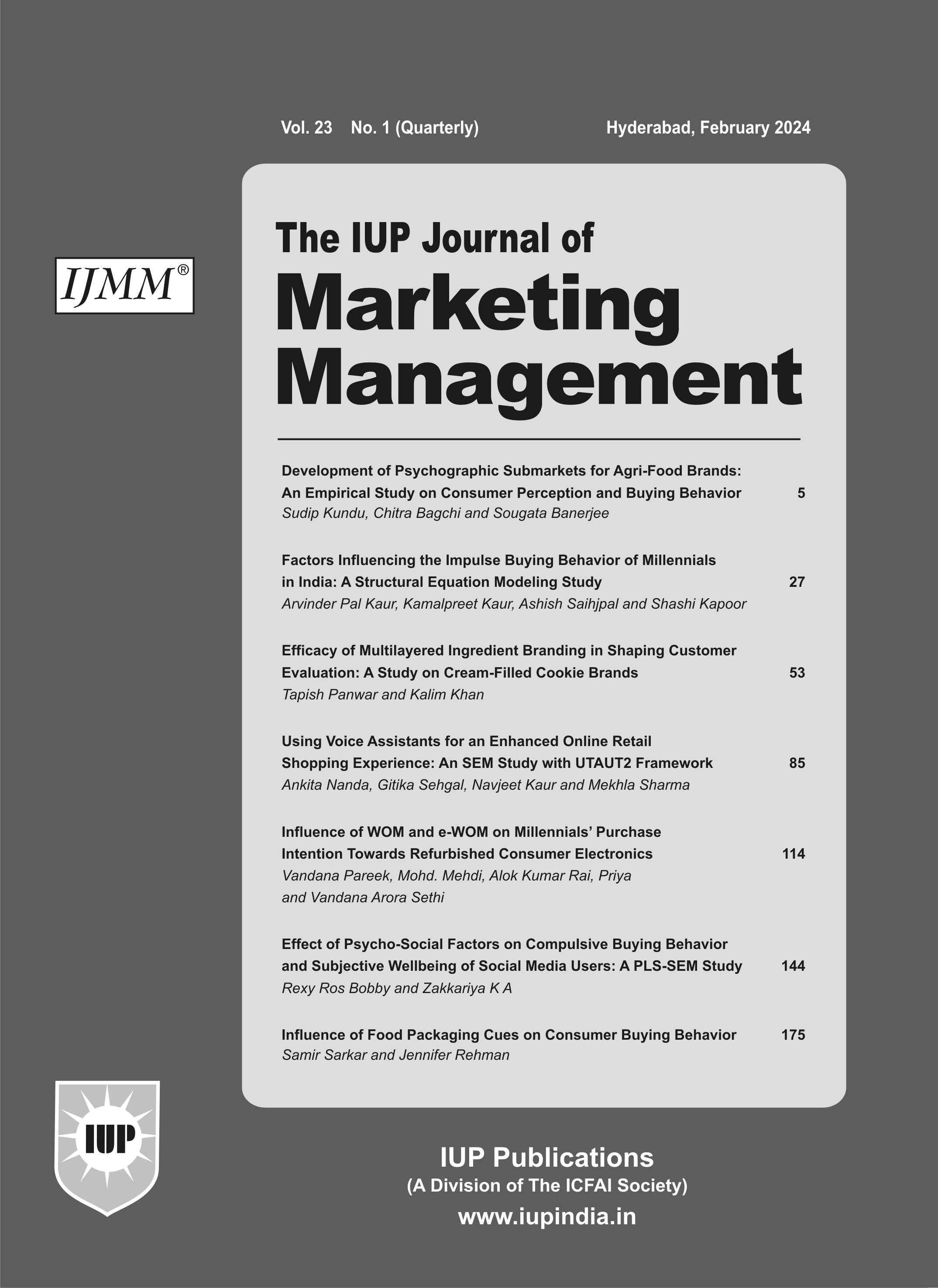
Feb'23
The IUP Journal of Marketing Management
Archives
Customers' Perceptions Towards Food Ordering Applications in Punjab
ith the emergence of a number of food ordering applications in the market, it has become equally challenging for customers to choose from the available applications. The objective of this study is to determine the level of awareness about online food ordering applications among customers. Further, the study evaluates the factors affecting customer perception towards online food ordering applications in Punjab. The study also determines the influence of demographic variables on the buying behavior of customers on online food ordering apps. The primary research data was collected through a structured questionnaire from 485 respondents who prefer ordering food through virtual applications, and SPSS software was used for analysis. Factor analysis was employed to find out the behavior of respondents towards food delivery applications. ANOVA was applied to check the impact of demographics on customer perception. The study identified eight factors affecting customer perception towards food ordering applications, i.e., discounts and offers, perceived ease of use, customer support, convenient operating hours, reliability, restaurant choice and variety, alternative mode of payment and serviceability of which 'discounts and offers' was found to be the most important factor. Further, the findings of the study revealed a significant role of demographic variables such as age, education, occupation and income in affecting customers buying behavior towards food ordering applications. FullArticle...
Influence of Social Media Marketing on Brand Consciousness, Brand Trust and Purchase Intention with Reference to Fast Fashion Industry
The study analyzes the impact of Social Media Marketing (SMM) activities on Brand Consciousness (BC), Brand Trust (BT) and Purchase Intention (PI) of fast fashion consumers. The study adopted quantitative descriptive approach, which included social media users in the age group of 16-40 years. Convenience sampling method was applied and data was collected via online questionnaires administered to 200 brand followers. The data was examined through SEM technique using Smart PLS software. The results of the study show that SMM had a significant impact on brand consciousness and brand trust, which in turn also had a significant impact on purchase intention of consumers. Thus, the study helps in understanding consumer behavior and suggests some effective strategies to strengthen the relationship between current and potential consumers. It highlights that social media plays a vital role in marketing, which in turn assists the marketers in influencing consumers' PI through BC and BT. FullArticle...
Impact of Nutrition Labeling on Consumers' Buying Behavior with Reference to Packaged Food Products
The attitude of consumers of packaged food towards the nutritional aspect of food is increasing every day, and in this context, the product's food labels play a very important role, providing pertinent information to consumers about the nutritional aspects. Food labeling allows consumers to make well-informed decisions while purchasing and consuming any food product. A tremendous growth in the consumption of packaged food has been observed in the last few years. This study focuses on the impact of nutrition labeling on consumer buying behavior. A sample of 243 respondents was surveyed to know the factors that determine consumer buying behavior and the impact of nutrition labeling on packaged food products on consumer buying behavior; factor analysis was done to get appropriate results. The study found that the factors that determine consumer buying behavior are nutritional values, labeling as a selection criterion, focus on family requirements, and brand comparison. It is also found that nutrition labeling has a significant impact on the buying behavior of consumers. FullArticle...
Social Messages in Advertising: Examining the Relationship Among Attitude Towards Advertisement, Brand and Purchase Intention of Customers
Although social issues or social message advertisements are used by brands to influence buying behavior, not much research has been done to evaluate the consumer behavior formed due to such advertisements in India. The study was carried out to investigate the relationship among Attitude Towards Advertisement with a Social Message (ATASM), Attitude Towards Brand (ATB) and Purchase Intention of Customer (PIC). ATB as a mediator between ATASM and PIC was also examined in this study. The proposed model's interrelationships were investigated using Structural Equation Modeling (SEM). A quantitative survey was conducted among university students, and the data was gathered via a questionnaire. For the study, an advertisement of an online shopping company was shown to the respondents with a pseudo brand name. To test the hypotheses, 323 students were surveyed. The results confirm that both ATB and PIC are positively affected by ATASM. Also, PIC is positively influenced by ATB formed after watching the advertisement incorporating the social message. The study contributes by introducing a new perspective to the advertising literature. It also equips marketers and advertisers with the knowledge to create commercial advertisements that include a social message. FullArticle...
Cause-Related Video Ads: The Long and the Short of It
A video ad that overcommunicates and elaborates on a cause begets less positive responses from its viewers. The objective of this study, conducted in five phases, was to find out if the responses of viewers change with the change in the duration of cause-related video ads. The respondents were exposed to such ads of varying durations-short, medium and long. Their perception-of-advertiser's-credibility and attitude-toward-the-ad were found to be more positive in case of short ads. As per the results of the study, short-duration cause-related video ads generate more positive viewer responses. FullArticle...